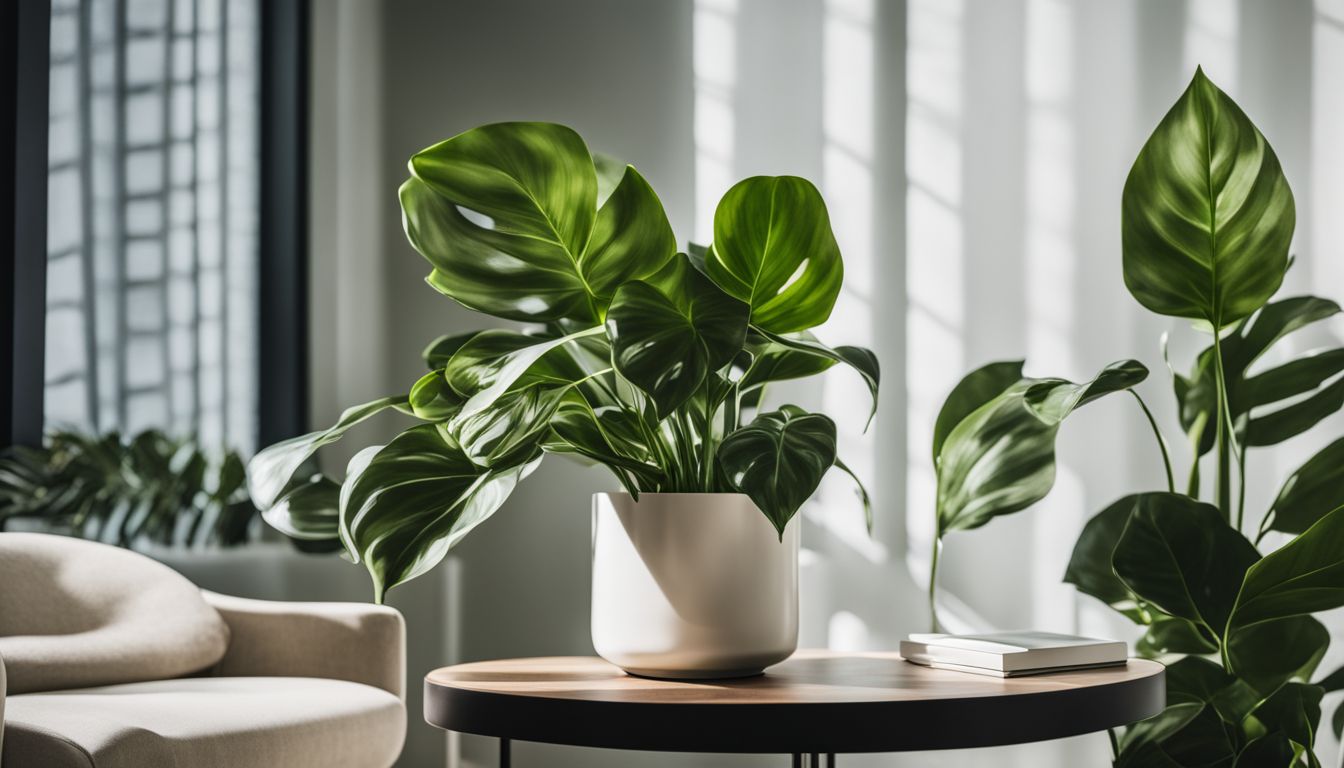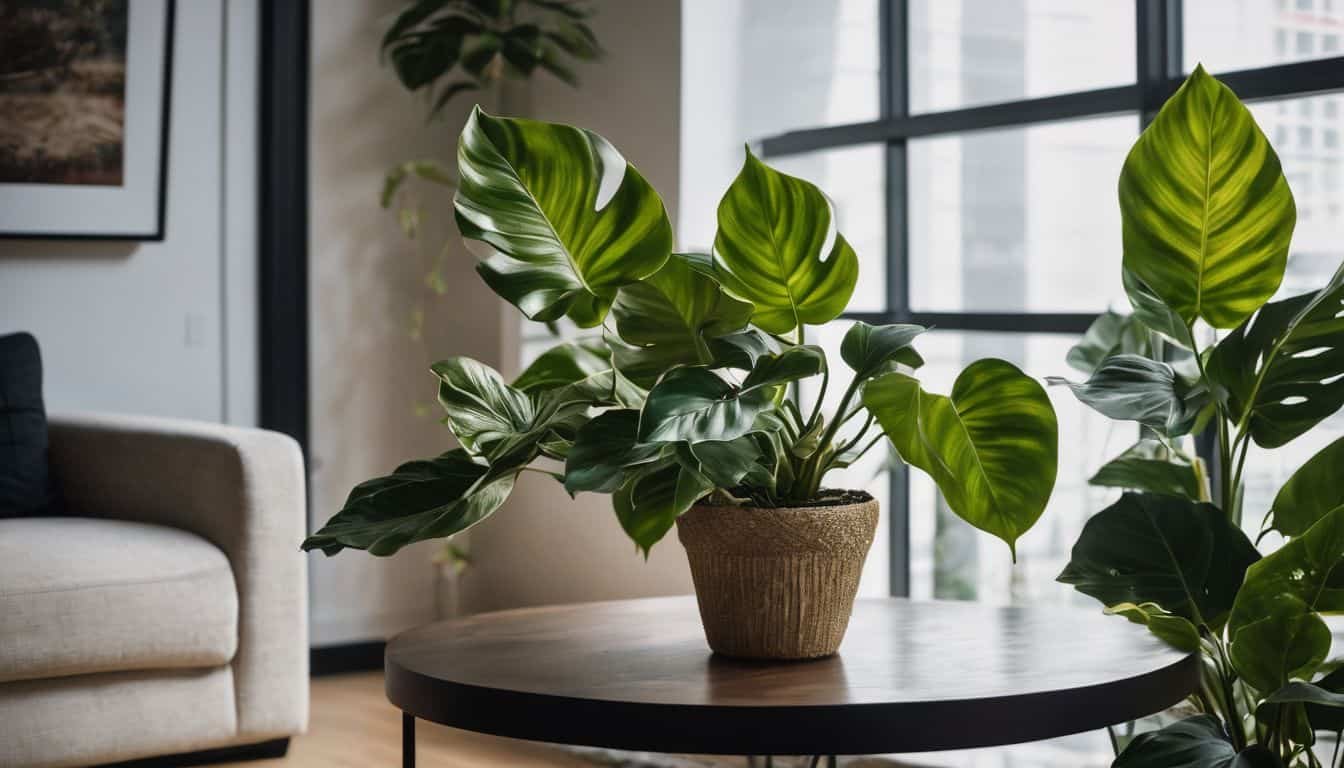Meet the Philodendron Birkin Plant, a beautiful plant with white stripey leaves. This special green friend can stay with you a long time and loves bright places without direct sun. It’s not hard to take care of, but it does like its soil a bit wet and prefers warm rooms that aren’t too dry.
The Philodendron Birkin comes from a cool change in its genes. That’s why its leaves have neat patterns. People love this plant because it is easy to grow inside their houses or offices.
For your Philodendron Birkin to be happy, keep the room warm between 65-85°F and make sure there’s enough moisture in the air. The dirt you put it in should let water drain out well and have some peat moss, perlite, and regular potting soil mixed together.
Give your plant water when the top two inches of dirt are dry, maybe once every week. But don’t give it too much! If it gets too wet around the roots, they can rot away. When spring and summer come around—the growing season—feed your plant some liquid food once each month so that it can get big and strong.
Cut off any old or broken leaves when you see them to keep things tidy. And remember to move your plant into a bigger home about every one or two years since they do best when their roots fill up the pot pretty well.
Keep an eye out for tiny bugs that might want to harm your Philodendron Birkin like mealybugs, spider mites, and aphids. Also watch for sad signs like leaves turning yellow with brown edges or starting to curl up or fall off—and take action quickly if you spot trouble!
This guide will walk you through giving great care for your Philodendron Birkin—including how to make more plants by propagation—to help you enjoy watching this amazing leafy buddy thrive at home! This charming plant waits for no one; let’s start now!
Key Takeaways
- Philodendron Birkin needs bright, indirect light and likes the temperature to be between 65-85 degrees Fahrenheit with high humidity.
- Water the plant when the top two inches of soil are dry and use a well – draining soil mix to prevent root rot.
- Fertilize once a month during growing seasons with balanced fertilizer and prune dead or yellow leaves to keep it healthy.
- Look out for pests like mealybugs or spider mites, and treat them quickly. Also watch for signs of overwatering like yellow leaves.
- Provide support such as a moss pole for climbing, repot when needed, and you can make new plants by dividing offsets.
Understanding the Philodendron Birkin’s Unique Traits

The Philodendron Birkin is a captivating plant with origins in South America, known for its striking variegated leaves that feature bold white or cream stripes. Its unique leaf patterns make it a popular choice among plant enthusiasts looking to add a touch of elegance to their indoor spaces.
Origins and History
Philodendron Birkin is a special plant. It comes from a parent called Philodendron Rojo Congo. This happened because of something called a mutation. Mutations can change plants in new ways.
These changes made the Birkin lose its white stripes, making it one-of-a-kind.
This lovely houseplant is part of the big Aroid family. People love it for its green leaves with cool white lines that look like pinstripes. There are more than 450 kinds of philodendrons, and each one is different and interesting.
I find it amazing how nature creates such unique plants as my Philodendron Birkin. Every time I look at those striking patterns on the leaves, I remember there’s always something new to discover about these wonderful greens in our homes.
Distinctive Leaf Patterns
After learning about where Philodendron Birkin comes from, let’s talk about what makes it stand out – the leaf patterns. This plant has amazing leaves that show off green and white stripes.
They look like someone drew neat lines on them with great care. At first, new leaves are all white. Then as they get older, the stripes start to appear.
The striped look of a Philodendron Birkin is not something you see in every plant. It happens because of a change in the plant’s genes, kind of like a happy accident that turned out beautiful! Keep these plants in bright, indirect light so their stripes stay bold and clear.
Too much direct sunlight might hurt their pretty pattern.
Taking care of your Birkin means watching its leaves closely. The stripes can tell you a lot about how happy your plant is. If the green starts taking over, your plant might want more light but not too much! Just remember, each leaf is special and adds character to this indoor beauty as it keeps growing strong and healthy by your side.
Essential Care for Philodendron Birkin

To ensure the optimal growth of your Philodendron Birkin, it is crucial to provide the right conditions. This includes placing the plant in bright, indirect light, watering it when the top inch of soil feels dry, using a well-draining potting mix, and maintaining a consistent temperature between 65-80°F with high humidity levels.
Optimal Lighting Conditions
I make sure my Philodendron Birkin gets the light it needs. It loves bright, indirect light for about 8-12 hours a day. This helps it grow well and keeps its leaves looking great. I keep mine near a window where the sun doesn’t hit directly on it because too much direct sun can hurt its leaves.
It’s important that my plant isn’t stuck in a dark room either. Philodendron Birkins don’t do well without enough light; their growth slows down and they might not look as pretty. I check every so often to see if the lighting is still good, moving the plant if it needs more light to stay healthy and happy.
Proper Watering Techniques
Philodendron Birkin plants need proper watering for their well-being. Here’s the best way to water them:
- Water thoroughly, allowing the top few inches of soil to dry before watering again.
- Ensure the plant is in well – draining potting soil and receive bright indirect light.
- Water once a week, ensuring the top two inches of soil are dry before watering.
- Avoid overwatering to prevent root rot and only water when the top 2 inches of soil is dry.
- Never let the plant sit in water, always allow excess water to drain away.
The Best Soil Mix
To ensure your Philodendron Birkin plant thrives, it’s crucial to provide the right soil mix. A well-draining and aerated mix is essential for its health. You can prepare a suitable soil mix by combining equal parts of peat moss, perlite, and potting soil.
Additionally, adding some orchid bark and charcoal to the mix can enhance drainage and aeration, promoting a healthy root system for your Philodendron Birkin.
It’s important to note that the best soil mix should be slightly acidic in nature. This helps in replicating the natural habitat of the plant and supports its overall growth. The combination of peat, perlite, potting soil, orchid bark, and charcoal creates an optimal environment for your Philodendron Birkin to flourish.
Remember that proper preparation of this soil mix sets a strong foundation for the well-being of your beloved plant.
Ideal Temperature and Humidity Levels
The ideal temperature for Philodendron Birkin is between 65 to 85 degrees Fahrenheit. This range provides the perfect conditions for the plant to thrive. Moreover, maintaining a humidity level above 60% is recommended for the optimal growth of your Philodendron Birkin.
These conditions will ensure that your plant stays healthy and vibrant throughout its growing season.
Understanding these essential temperature and humidity levels is critical in creating an environment where your Philodendron Birkin can flourish. Now let’s delve into understanding the unique traits of this remarkable plant.
Philodendron Birkin’s Climbing Habits
Philodendron Birkin is a climbing plant. It has aerial roots that help it climb and attach to surfaces for support. These roots also absorb water and nutrients from the air. When growing, it’s essential to provide some kind of support like a moss pole or trellis to encourage its climbing habit.
The Philodendron Birkin, with proper care and maintenance, can grow lush and full. As the plant matures, its climbing tendencies become more evident. Regularly observing the growth pattern will allow you to provide suitable support for its climbing nature, ensuring healthy development.
Nourishing Your Philodendron Birkin
Nourishing your Philodendron Birkin is essential for its overall health and growth. This section will cover the proper fertilization schedule, as well as pruning and maintenance tips to keep your plant thriving.
Fertilization Schedule
I fertilize my Philodendron Birkin every four weeks to help it grow well. I use a balanced 10-10-10 liquid houseplant fertilizer, diluted as instructed, for the best results. Here’s my detailed fertilization schedule:
- Fertilize once a month during spring and summer.
- Be cautious with feeding to avoid root burn and yellowing leaves.
- Remember, too much feeding can harm the plant.
- The fertilizer should support the plant for optimal success, not speedy, unnatural growth.
- Fertilization is crucial for the overall health and well-being of my Philodendron Birkin.
- Proper fertilization nourishes the soil and provides essential nutrients for thriving.
Pruning and Maintenance Tips
Pruning the Philodendron Birkin is simple and helps keep it healthy. Here are some basic tips:
- Regularly remove any yellow or dying leaves to maintain plant health.
- Use clean scissors or shears to prune, preventing diseases from spreading.
- Cut just above a leaf node when trimming, which encourages new growth.
- Look for damaged or discolored leaves and trim them away to promote overall plant vitality.
Troubleshooting Common Issues
If you notice yellowing leaves or brown tips on your Philodendron Birkin, it may be a sign of improper watering or lighting. Additionally, leaf curling and dropping could indicate issues with temperature or humidity levels in the plant’s environment.
Proper pest and disease management is also essential to keep your Philodendron Birkin thriving.
Yellowing Leaves and Brown Tips
Yellowing leaves and brown tips are common issues with Philodendron Birkin plants. They can be caused by various factors such as soil moisture imbalance, lack of humidity, pests like aphids and spider mites, overwatering, or underwatering. Here’s how to deal with these problems:
- Ensure the soil moisture is balanced by following a consistent watering schedule and using well – draining soil.
- Increase humidity around the plant, especially if it is placed in a dry environment. You can use a humidifier or mist the leaves regularly.
- Check for signs of pests like aphids or spider mites and treat them using insecticidal soap if present.
- If you notice overwatering symptoms such as yellowing edges on the leaves, adjust your watering frequency and allow the soil to dry out slightly between waterings.
- Monitor the plant closely for rapid yellowing, stunted growth, or a rotten brown base – these could indicate more serious issues that require immediate attention below the soil line.
- Regularly inspect your Philodendron Birkin for any changes in leaf color, texture, or overall health to catch problems early on.
- Follow proper care practices including maintaining optimal lighting conditions, fertilizing as needed, and providing appropriate temperature and humidity levels to promote overall plant health.
Leaf Curling and Dropping
When the leaves of your Philodendron Birkin start curling or dropping, it’s essential to understand the possible causes to address the issue effectively. Here are key points to consider:
- Overwatering: Excessive moisture can lead to curling leaves. Proper drainage and allowing the soil to dry slightly between waterings is crucial.
- Tap Water: Water with chemicals like chlorine and fluoride can cause leaf curling. Opt for filtered or distilled water.
- Cold and Dry Environments: Philodendron Birkin prefers warm and humid conditions, so ensure adequate warmth and humidity levels in its environment.
- Fertilizer Overload: Too much fertilizer can cause leaf tips to curl and turn brown. Follow a balanced fertilization schedule.
- Underwatering: Insufficient water can stress the plant, resulting in curled or drooping leaves. Maintain appropriate moisture levels based on the plant’s needs.
Pest and Disease Management
Dealing with pests and diseases is crucial for keeping your Philodendron Birkin healthy. Here’s how I manage these issues:
- Regularly inspect the leaves for pests such as mealy bugs, spider mites, and aphids, as they can quickly infest the plant.
- If you notice any signs of pest infestation, immediately isolate the affected plant to prevent further spreading within your collection.
- To tackle mealy bugs, gently wipe the affected areas with a cotton swab dipped in rubbing alcohol.
- For spider mites and aphids, consider using a natural insecticidal soap spray or neem oil to control their population.
- Powdery mildew can be addressed by improving air circulation around the plant and avoiding overhead watering to reduce humidity levels that promote its growth.
- In case of leaf yellowing or browning tips without pest presence, it might indicate overwatering or poor drainage; adjust your watering routine accordingly.
- To protect your pets from potential toxicity, place the Philodendron Birkin in an area where they cannot access it.
Propagation and Repotting Philodendron Birkin
Propagating Philodendron Birkin is best done by dividing new offsets when repotting.
Conclusion: Enjoying Your Thriving Philodendron Birkin
In conclusion, growing and caring for Philodendron Birkin plants is straightforward and rewarding. The practical tips provided in this guide ensure efficient care techniques that are easy to implement.
Applying these strategies can lead to thriving, healthy plants with glossy foliage and stunning striped leaves. For further learning, consider exploring additional resources or services related to indoor plant care.
Remember, with the right care, your Philodendron Birkin will flourish beautifully in your home.
FAQs
1. What is a Philodendron Birkin plant?
Philodendron Birkin is a hybrid indoor plant known for its pretty leaves. It’s like the philodendron ‘Rojo Congo’ but has its own style.
2. Why are my Philodendron Birkin’s leaves turning yellow?
Yellow leaves on a Philodendron Birkin can be from too much water or not enough light. Make sure it gets just enough water and light to stay healthy.
3. Is the Philodendron Birkin toxic to pets?
Yes, this plant is toxic to pets. If you have cats or dogs, keep your Philodendron where they can’t nibble on it.
4. How do I keep my Philodendron Birkin’s variegation looking good?
To keep its special leaf patterns, give your plant bright light but not direct sun which might cause loss of variegation.
5. What kind of soil does a Philodendron Birkin need?
Mix potting soil with stuff like spaghnum moss or mulch to help your birkin grow best!

